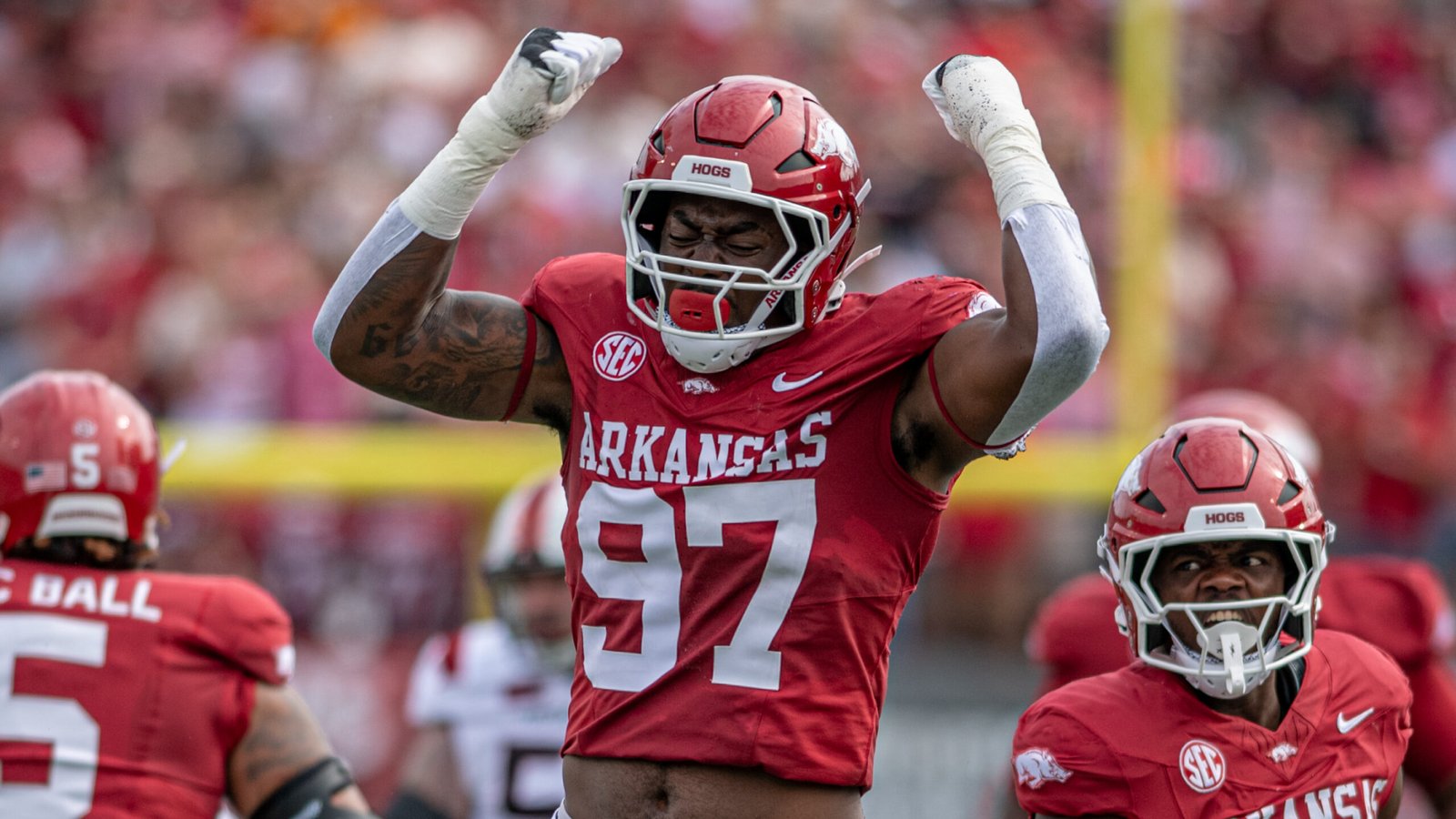Hogs Football
Razorbacks defense faces high-stakes test against Notre Dame offense
Arkansas’ defense must rise to disrupt Notre Dame’s dynamic run game while trusting an offense with exploitable matchups

FAYETTEVILLE, Ark. — When the Razorbacks host Notre Dame, what unfolds won’t merely be a non-conference clash.
It’s a crossroads for Arkansas’ defense, and a chance for Notre Dame’s offense to validate national expectations.
Much of the spotlight has centered on how the Hogs will account for Notre Dame’s dual-threat backfield of Jeremiyah Love and Jadarian Price, plus the precise passing game under C.J. Carr.
Equally compelling is can the Hogs protect their lead lines, force stops, and avoid collapse in the fourth quarter?
Arkansas enters the contest at 2–2, having scored over 30 points in each game and eclipsed 50 twice this season. Yet the defense has been vulnerable, allowing 36.5 points combined over two recent losses.
Meanwhile, Notre Dame’s offense has been prolific, 41 points in a narrow loss to Texas A&M, followed by a 56-30 dismantling of Purdue.
For Arkansas, it’s a test of character.
“We’ve got to have the physicality,” Pittman said this week. “If you don’t run to the football and you don’t tackle well, it’s not going to work.”
Running threat: Love & price must be accounted for
Notre Dame’s strength, perhaps most obviously, remains its run game. Love is averaging roughly 94.7 yards per game, ranking among the top 25 rushers nationally, with Price serving as an explosive complementary threat.
Pittman doesn’t shy from the praise.
“I’m looking at tape, this guy is sensational. He’s fast, he’s mean. He can catch,” Pittman said of Love. “Price … we call them 1A, 1B.”
The Razorback front will need to control gaps, maintain discipline on edge contain, and limit mismatches in space. Arkansas’ defensive line must generate push, freeing linebackers to flow to the ball and avoid being gashed by cutbacks.
Saying it is one thing. Accomplishing it is another.
Beyond just stopping the run, Arkansas must guard against screen passes, wheel routes, and motion schemes intended to manipulate linebackers. Notre Dame’s play-action packages are built to punish aggressive fronts. Should Arkansas over-commit, it opens the door for big plays downfield.
Passing game: Carr, matchups, and mistakes
While Carr is not a household name yet, his efficiency has been key. He has thrown for 737 yards across three games (245.7 per game) with five touchdowns and two picks.
His deep comeback routes — especially from roll protection sets — have become a reliable weapon.
“They throw the deep comeback as good as anybody,” Pittman said.
Notre Dame’s secondary is known for disciplined coverage and tackling in space. In that sense, Arkansas cannot expect to simply outgun them through the air.
Taylen Green and his receivers must navigate tight windows, avoid ill-timed throws, and exploit weak spots when the Irish adjust.
Matchup data reinforces the opportunity: Arkansas tight ends have averaged 23.9 yards per reception this season, ranking second among SEC tight ends, while Notre Dame’s defense has allowed 14.0 yards per reception, placing it among the subpar FBS defenses in this metric.
Pressure & situational football
A major opportunity lies in disruption. Arkansas will need timely pressures to force Carr into mistakes, especially late in downs or on third down. Fatigue in Notre Dame’s secondary could invite big plays in the fourth quarter — if the Razorbacks hang within range. SI+1
Meanwhile, situational execution—third-down stops, red zone defense, tackling in space—may decide the margin. If Arkansas can bend without breaking and deliver key stops, it can blunt Notre Dame’s upside.
Leadership, adjustments, and momentum
Offensive line play is a foundation that will support all defensive ambitions.
Arkansas’ offensive line is graded among the highest of Power Five squads so far, which gives the Razorbacks a structural advantage in time and balance.
Arkansas also leans on younger defensive pieces like Quincy Rhodes Jr., a junior defensive end who has made strides in his role.
Veteran linebackers and secondary leaders will be key in adjusting to motion, disguising coverages, and communicating under duress.
On the opponent’s side, the Irish are adapting to new defensive coordinator Chris Ash, who took over this season.
That shift has included varying coverages and attempts to stabilize weaknesses, but those changes may create exploitable windows early on.
Arkansas must set the tone early, wining the line of scrimmage, play with urgency, force adjustments, and impose their identity.
As I said earlier, it’s all easy to say. We’ll see if they can do it.
Key takeaways
• Stopping the run is paramount — Arkansas must contain Love and Price through disciplined gap control and gap integrity.
• Matchups in coverage are critical — Arkansas’ tight ends and receivers have exploitable speed and YPR potential against Notre Dame’s secondary.
• Situational defense and pressure win games — the Razorbacks must make key stops and force mistakes under duress to tilt momentum.


